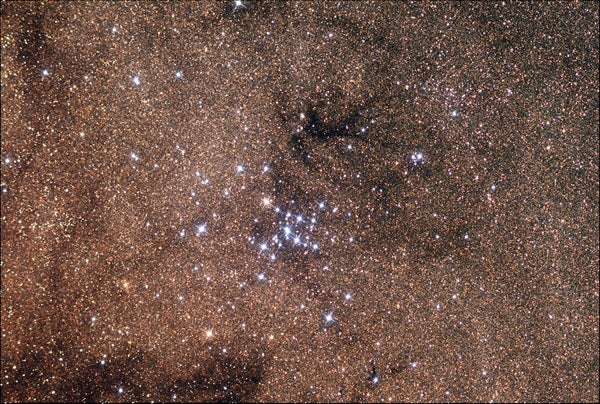Our summer sky is bespangled with hundreds of sparkling open star clusters. One of the finest is M7 in Scorpius. It lies just 5° east-northeast of the Scorpion’s stinger stars: Shaula (Lambda [λ] Scorpii) and Lesath (Upsilon [υ] Scorpii). Under dark skies, M7 can be seen by the naked eye as a small patch of light against the glow of the surrounding Milky Way. Depending on where you live, you will need a good view to the south to spot it, since it lies nearly 35° south of the celestial equator. That makes it the southernmost member of the Messier catalog.
Ptolemy must have enjoyed a good view of M7 in A.D. 130 because he subsequently noted the cluster as a cloudy patch in his monumental tome Almagest. That’s why, even today, M7 is still sometimes referred to as Ptolemy’s Cluster. Had Ptolemy had binoculars, however, he would have immediately seen the cloudy patch resolve into a striking array of stars spanning more than 30′. Astronomers estimate the cluster is some 980 light-years away and stretches about 25 light-years across. Between 80 and 100 stars call M7 home, although a plethora of field stars in the surrounding region make the exact number hard to pin down.
Because M7 covers a wide swath of sky, binoculars and wide-field scopes are best for appreciating the object’s beauty. More than 30 of its stars are brighter than 10th magnitude and visible in 50mm binoculars. Through 10x50s, the brighter members appear to float in front of a field strewn with fainter points, creating a faux 3D effect. Several of those cluster stars show subtle hues of yellow and blue.
All of M7’s stars were born from an interstellar cloud of gas and dust about 200 million years ago. And that same cloud also gave birth to the open cluster M6, found 4° to the northwest. While their stars share a common ancestry, they are, at best, distant relatives, as M6 is half again the distance.
Make sure to explore Astronomy’s full list of 101 cosmic objects you must see. New entries will be added each week throughout 2022.
To get the latest astronomical news and observing content delivered directly to your door, subscribe to Astronomy magazine today!










